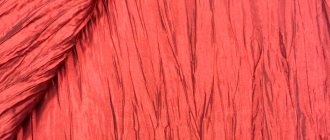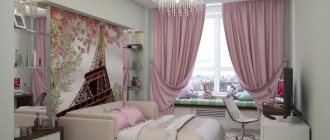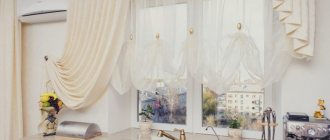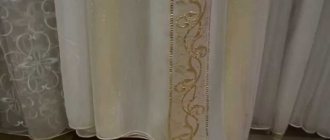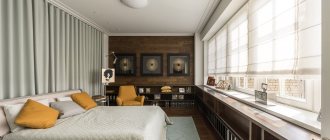Features of panel curtains
Like all types of curtains, they have their own aesthetic and functional characteristics.
- Easy to use and maintain.
- The special fastening allows them to be used not only as decoration for a window opening, but also as a partition to divide a room.
- Thanks to the multi-panel design, you can combine the canvases in any order and create stylish and interesting images.
- Thanks to their laconic appearance, they take up minimal space.
The main advantages of Japanese curtains
Japanese curtains decorate the interior and protect from the bright sun Source www.dizainvfoto.ru Japanese vertical curtains with a floral pattern will decorate your interior Source art-interior.moscow
These curtains have numerous advantages that have ensured them such great popularity. Here are some of them:
- Japanese curtains take up minimal space, so they can be used even in the smallest spaces.
- Due to the fact that the fabric does not drape, it collects less dust - which means fewer problems for allergy sufferers and less need for cleaning.
- And when cleaning curtains is still necessary, standard household chemicals do an excellent job.
- Japanese curtains are made from a variety of materials and in different colors, and a suitable option can be selected for almost every interior.
- Most of these curtains have a very affordable price. Of course, as everywhere else, there are also premium solutions, for example, made from expensive raw materials or with an exclusive design - but everything is not limited to them.
Japanese curtains go well with a light interior Source homeli.ru
Material
Artificial and natural materials are used to make Japanese paintings.
Bamboo
They do not accumulate dust and are very easy to clean. According to Feng Shui, they absorb negative energy and prevent it from entering the house. They will fit especially well into an oriental or eco-style interior with themed design details.
Linen
Practicality and comfort. Perfect for any layout, combined with ceramics and wood, linen panels are aesthetics and harmony.
Organza
Organza curtains in Japanese style are sophistication without unnecessary details. For anyone who likes oriental exoticism, this fabric will help create the right mood in the room.
Plastic
For modern solutions, thin plastic panels have been invented. Exquisitely simple and strict. They fit perfectly into minimalist interiors, giving them a special style.
Silk
Mysterious and sophisticated. He always looks interesting and attractive. Silk curtains will make the room especially stylish.
Satin
It can be plain or with patterns. Allows you to achieve an original and unique look. Various shades and colors make it possible to choose the most suitable combination for interior decoration.
Rice paper
They let in a lot of light and give the room a special flavor, which is appreciated by many connoisseurs and lovers of Japanese style.
Blackout
Vertical panels made of this type of fabric look strict and stylish, and when unfolded, they completely isolate the space from external light.
Materials used for the manufacture of Japanese panels
Canvases can be formed from various fabrics - synthetic, natural, mixed.
Eco-friendly materials are closer to the Japanese style - cotton, linen, silk, hemp. They are not cheap, but they are antiseptic and do not cause allergies.
Synthetic fabrics (polyester, acrylic, polyester) are cheaper than natural ones, more wear-resistant, but always safe.
Advice: the ideal option is to use fabrics made by weaving natural and synthetic threads. They have a presentable appearance, are easy to care for, and belong to the middle price category.
The transparency of the fabrics is selected individually, taking into account the characteristics of the room and the preferences of the home owners.
In darkened rooms it is advisable to use transparent or translucent panels, in light rooms - denser ones.
You can create a night effect during the day using BLOCKOUT panels that block sunlight by 100%.
To make Japanese curtains, not only fabric is used, but also rice paper, colored plastic, rattan, and bamboo. They differ from ordinary curtains in their unusual design and simplicity of construction.
To add some zest to the interior, it is recommended to use fabrics of different textures and colors.
The use of contrasting materials (thick-transparent, light-dark, plain-colored) will allow you to create an extraordinary design.
Due to the fact that the fabrics of Japanese curtains are well stretched, various prints, landscapes, and paintings look beautiful on them. Such panels will organically fit into the interior of a room in a minimalist oriental style.
Curtain sizes
Japanese panels come only short or floor-length, all other forms are excluded.
Long
They can be either a decorative element for windows or an excellent solution for decorating niches, walls, doorways, or can be used as cabinet doors.
The photo shows long Japanese curtains in the living room interior.
Short
Translucent short curtains up to the window sill made of a plain light material are suitable for small windows. They are able to visually expand the window opening and give a feeling of abundance of space and air.
The photo shows the interior of a small bedroom with a window decorated with short Japanese curtains.
DIY Japanese curtains
This happens in several steps:
- You cut out strips 60 cm wide (they are all the same and rectangular). Along the entire perimeter of the strip (except for the bottom), you leave a hem allowance (about 0.5-0.7 cm). The bottom is processed with a drawstring.
- The length of the panel is selected based on the finished curtain + 1-2 cm for Velcro.
- Carefully iron the stripes, paying special attention to the side seams.
- Finally, place the weighting material at the bottom of the curtains.
Beige and white Japanese curtains in the living room
Floral Japanese curtains in orange tones in the living room
Elegant translucent Japanese curtains in the living room
Peach and white Japanese curtains in the living room
With the help of Japanese curtains and blinds, you can easily transform the interior of your apartment, improving it and highlighting new zones in it.
Photos in the interior of the rooms
Japanese curtains provide unlimited freedom when decorating any room.
Kitchen
Most often used for spacious kitchens. They are practical, so they are ideal for this less than ideally clean room. And thanks to their laconicism and simplicity, they will fit into any design and complete the overall design of the interior.
The photo shows a kitchen decorated with brown Japanese linens.
Bedroom
For bedrooms, choose pastel and muted colors that echo nature. Cloths made from natural materials with dust-repellent properties will provide reliable protection against allergic reactions.
Children's room
When decorating a window in a nursery, you can create a special mood in the room using various prints. The design is also used to delimit a room into a recreation and play area or acts as a partition for a room shared by two children.
The photo shows a children's room and green Japanese curtains with a geometric pattern.
Living room or hall
The overall design of the products and the material are chosen to match the style of the interior. Most often, long canvases with floral or geometric patterns are used. Sometimes the panels are combined with other curtains; such compositions go well with living room interior items.
Balcony and loggia
Protect from sunlight and strong heat. The choice of color and ornament can influence the perception of the geometry of the balcony. Light shades will expand the space, dark shades will make it smaller and more comfortable.
Interior
Japanese panels are not only utilitarian and beautiful curtains; they are also used to create sliding partitions or replace interior doors and partitions.
Wardrobe
It will allow you to solve several problems, in particular, to elegantly close the entrance to the dressing room, use thick curtains instead of a screen, or fence off an area for placing a mirror.
For bay window
Smooth canvases of Japanese curtains in the design of a bay window occupy a minimum of space and do not overload the interior of the room.
Japanese style curtains - what are they?
Japanese curtains are smooth sliding fabric panels of small width, which, unlike classic ones, look like a screen or screen. Such curtains are usually attached using a multi-level ceiling cornice. They move around the window like a screen and always remain straight (like blinds) due to the weighting at the bottom.
Red Japanese curtains with red flowers in the living room
Japanese curtains are easy to install, easy to care for, have maximum functionality and will become an excellent decorative element in any of your rooms: hall, living room, kitchen, bedroom, balcony. Different types of curtains differ in coloring, which may include traditional Japanese patterns: bamboo, hieroglyphs, cherry blossoms, fish and other designs and shades.
All models of Japanese curtains look great on large stained glass windows (or on large balcony windows), they add even more light and elegance to the space. Usually made from natural fabrics: cotton, silk, bamboo, linen and others. Traditionally light and soft shades: pink, white, beige, light green, blue. Curtains are decorated with silk threads, braid and laces.
White and gray Japanese curtains in the living room
The main advantages of Japanese curtains:
- practically do not absorb dust;
- easy to care for – easily removed from frames and washed;
- varying the movement of curtains due to their small width, variety of designs;
- the ability to include curtains in smart home technology.
Stylish black Japanese curtains to divide the space in the living room
Beige Japanese curtains in the living room
White Japanese curtains in a large living room
Color spectrum
Japanese paintings will look even more harmonious in the interior if you choose the right one, not only the texture, but also the color.
Brown
Multifaceted, rich, but at the same time neutral color. He is not dominant. Brown color is a natural shade that is suitable for elegant and solid interiors.
Grey
In order not to end up with a too dull and conservative atmosphere in the room, when choosing this color you need to know a sense of proportion and carefully think through each shade and color combination.
Green
The color of calm, imbues the space with a natural theme. Green Japanese curtains create a positive perception of the outside world and the interior as a whole.
The photo shows a white dining room and green Japanese paintings on the windows.
White
This is a sign of excellent taste and grace, because it goes well with any interior and color of furniture, and also gives the living space a festive look.
Black and white
The pinnacle of classics, the absolute peak of harmony. Combines with a variety of bright or muted interior palettes. The black and white combination gives the design a strict laconicism and an incredibly luxurious look. It can become both a background and an accent.
Violet
A stunning, deep, rich and incredibly picturesque color that undoubtedly attracts attention.
Pink
Mobilizes and tones, provides ample opportunities to express your taste. It can induce a dreamy mood and is good for relaxation.
Beige
It will fill the design with a special aesthetics, add completeness and allow you to add more coziness and comfort to a cool or dark interior.
The photo shows a living room in light colors with beige Japanese curtains on the window.
Advantages and disadvantages
When planning to buy Japanese curtains, you need to know in advance about the advantages and disadvantages of this exquisite window decoration. Their main advantages are the following:
- They make the interior laconic and provide a wide view from the windows;
- Uncomplicated cut and simple design. Anyone can hang a cornice for a Japanese curtain and the canvas itself;
- Huge variety of colors and sizes. There are many ready-made options on sale, but you can sew curtains to order using fabric with an exclusive pattern;
- Various fabric densities. Depending on the lighting in the room, you can choose the optimal type of canvas, from light rice paper to thick blackout;
- Strength and durability. Due to the absence of folds, the curtains last a long time and retain their original appearance.
Despite all the obvious advantages, Japanese curtains have a couple of disadvantages. For example, over time, the rollers and slats that ensure the movement of the canvases may lose mobility. Some people complain about difficulties in the process of removing and putting on cloths for washing.
Drawings and design of curtain panels
They give a special atmosphere and allow you to further emphasize the idea of style.
See how roller blinds look in the interior.
Plain
The traditional and laconic version does not draw attention to itself and does not stand out from the general background. Most often used to decorate rooms such as the bedroom or living room.
Flowers and vegetation
Floral and plant patterns give a feeling of calm. For example, in Japan, an orchid in the interior creates an atmosphere of peace and influences the perception of space, highlighting the advantages and hiding the disadvantages of the interior.
Openwork
These delicate, filigree patterns are well suited for a room such as a bedroom. They will make it more soaring, cozy and truly exclusive.
Sakura
Japanese cherry trees depicted on canvases will create a unique blooming effect in the room. Thanks to their delicate shades, curtains with sakura will look most harmonious in an interior made in brown, beige, turquoise or gray.
With transparent middle
An elegant transparent middle, combined with dense side parts, will support the overall style of the room. This option is suitable for rooms that do not need to be hidden from ultraviolet rays.
Geometry
The diversity of this pattern allows it to be used in completely different rooms. Abstraction, stripes and strict squares will fit well into the minimalist design of a small room and add spaciousness and originality to it.
The photo shows Japanese curtains with a geometric print in the interior of the office.
Photo print
They resemble screens and look like photo curtains, so realistic drawings look great on them. They help create a non-trivial and memorable interior.
Interior style for panels
Panel curtains are necessary in traditional Japanese design; they act as an expressive detail in the interior of high-tech, minimalism and avant-garde styles. By emphasizing functionality, they can add elegance without making the space feel cluttered.
The presentation of the simplicity of Japanese style in interior design is only an appearance. Everything needs to be carefully thought out and logical accents made to achieve elegant asceticism.
All details must be in the same style. Japanese curtains, as an original detail, are suitable for anyone who wants to bring originality and exoticism to the interior without much effort and expense, or simply hide something from prying eyes. As an option, the photo shows a niche decorated with screen curtains.
Japanese curtain effectively hides a niche
The ladder panels look beautiful on the kitchen window
The photo shows an example of kitchen design
Japanese style panels in a small kitchen
Japanese curtains look great in spacious rooms with large windows (living rooms, bedrooms, kitchens). It is better not to hang one panel on narrow window openings - visually they will appear even smaller.
From a Japanese-style room it is necessary to remove massive furniture with a large number of shelves, drawers and other excesses. Housewives with experience in crocheting can make poufs for the floor, which will be a wonderful addition to the decoration of the living room.
Knitted poufs in the interior
If you need to close a niche or make a space partition, Japanese curtains will be a good solution. When installing panels in a one-room apartment, you can create a living room and a bedroom.
In the nursery, using a curtain-screen partition, you can create space for sleeping, studying, and playing. In the bedroom it will be a boudoir.
A partition in the kitchen will allow you to differentiate it into a “dining room” and a place for cooking. The models are practical, simple and will come in handy in any kitchen.
To present the Japanese style in the bedroom, you can use 2-3 panel curtains in soothing colors, harmoniously combined with each other. One of them may depict a traditional Japanese landscape.
According to ancient Japanese teachings, thoughtful contemplation is calming and leads to inner harmony. In addition, if you have insomnia, counting sakura flowers is much more pleasant than counting sheep jumping over a fence.
For a kitchen room, Japanese curtains of catchy colors with sharp contrasts and bright prints are undesirable. According to the Japanese culinary tradition, complete concentration on the process of preparing dishes or absorbing food is required.
You can combine models from several screens consisting of light and dense fabrics or use smooth and textured material, as well as traditional bamboo and straw. For small rooms, models of curtains up to the window sill are suitable, and for spacious rooms – panels up to the floor.
In the kitchen, it would be more practical to choose synthetic fabrics for curtains. They remove grease stains and cooking odors more easily.
An excellent solution would be to choose natural colors for a Japanese-style kitchen - moss, peat, leaves, stone. Japanese curtains with floral prints in cheerful shades combined with rich plain fabrics are suitable for a child's room. For the living room, instead of blinds, you can use a combination of Japanese curtain panels with organza and tulle.
Style decision
Also, these canvases can organically and beautifully fit into different interior styles.
Ethnic style
Rich colors, various patterns and ornaments are the main defining features of this style. The main thing is that the selected curtains are combined with the overall interior of the space. Natural materials and light transparent products are suitable.
The photo shows a room in an ethnic style with windows decorated with Japanese paintings.
Minimalism
The emphasis here is on the abundance of light and space. Therefore, special attention is paid to the selection and design of curtains. The modesty and unpretentiousness of the curtain panels are quite consistent with the spirit of this style.
Oriental
The interior should be as natural as possible, dividing the space with miniature screens, a minimum of furniture, straw mats and an abundance of accessories.
The photo shows the interior of a living room in an oriental style with Japanese curtains on the window.
Eco
This style does not use heavy and expensive fabrics. Canvases in neutral shades or Japanese jute curtains look especially harmonious.
Modern
The modern style features laconic lines and clear forms, as well as glossy textures, metal details, rough wood and smooth leather. Japanese window panels are suitable here, since the absence of draperies gives them a particularly neat and compact appearance.
High tech
The uniqueness of this style is in its rigor and functionality. Japanese curtains with geometric prints will emphasize the progressiveness of views, the modernity of the interior and will resonate in decoration or pieces of furniture.
Ways to control a cornice
Japanese curtains can be made from light and weightless fabrics, or from dense curtain-type fabric. Controlling their movement along the cornice is quite simple using a cord or automation.
- Manual cord control. The canvases must be independent of each other. You can move each one separately.
- Using manual control. Moreover, each panel is dependent on the neighboring one. Movement occurs in pairs and groups. If you pull both cords, the curtains will open or close together.
- For large window openings with wide leaves, the best solution is to use an automation console. This control is suitable for curtain rods with 3 to 5 guides. To activate the mechanism, just press a button on the control panel. The wire with the remote control will protrude beyond the eaves.
The materials from which curtain rods are made are plastic or metal profiles.
Options for combining Japanese panels
Japanese paintings unconditionally decorate the entire room and also have successful combinations and combinations.
With curtains (tulle, veil, etc.)
Light and translucent curtains look great in combination with Japanese curtains. It is possible to combine even several types of curtains on one window.
Various lengths
A great way to give your home a unique look without breaking the bank. This option is suitable for decorating a window with a balcony door.
Multicolored
They set a special mood for the entire interior and make the room bright and individual.
Japanese panel curtains - room for design
A variety of models and types of Japanese curtains will allow you to take into account the taste of everyone. A wide range of materials and colors are used to make such curtains and blinds. Various textured combinations look good - alternating organza and opaque fabrics, a light veil and thick curtains. A multi-level cornice allows you to fit about 10 panels, which will allow you to change the interior in a matter of seconds.
Japanese curtains softly diffuse light; with their help, you can create a loft-style design using white panels through which light from the balcony will softly shine into the living room or kitchen.
Japanese roller blinds are an ideal option for fabrics with complex patterns. The fabric never bunches up, so you and your guests can admire the beautiful look of the curtains. Any prints, patterns and colors can be used. Using thermal printing, you can design curtains with your own individual design, boldly mixing colors and textures. Modern designers manage to combine Japanese curtains with traditional curtains in living rooms.
White and gray Japanese curtains in the living room
Light green Japanese curtains in the living room to separate a secluded seating area
Living room
When decorating a living room, it is important to remember that this is the calling card of your home. Here you can choose both bright colors and calm pastel tones. A good solution for the living room is a transparent middle and dense panels along the edges. But this option is not suitable for a room with a south-facing balcony that needs to be protected from bright daylight.
Bright multi-colored Japanese curtains in the living room
Kitchen
For the housewife, the kitchen is the main room in the apartment. This is where she spends the most time; this is where the whole family has breakfast, lunch and dinner. Curtains for the kitchen should be made of high-quality fabrics; it is advisable to choose a simple and laconic design. For a small kitchen, you can choose translucent panels made of light fabrics; they will visually add space and air. If we talk about the psychology of color, then warm colors have a good effect on appetite: yellow, red, orange.
White translucent Japanese curtains in the kitchen
Red Japanese curtains in the kitchen
Bedroom
In the bedroom you need to create a pleasant twilight, dim lighting. To do this, you need to think about what texture and color are suitable. Pastel colors in combination with dark shades, for example, matching the bedspread, are good for the bedroom. Bamboo curtains look unusual.
Japanese curtains in the bedroom
Non-standard use
Japanese curtains are universal. They can be used not only in decorating a window opening.
As partitions
Sometimes multifunctional rooms need zoning of space. For example, a kitchen combined with a dining room, or a bathroom combined with a toilet. With the help of Japanese panels, you can easily and conveniently divide such rooms into independent sections.
See more examples of how to effectively use Japanese curtains to divide a room.
The photo shows a living room combined with a kitchen and Japanese panels as partitions.
Instead of cabinet doors
This option is suitable for saving space in small bedrooms. They do not clutter up the room and look weightless.
Step-by-step instructions - master class
By sticking to the basics, you can quickly and accurately create Japanese-style decor without the help of professionals. Making Japanese curtains with your own hands and window decoration is divided into several stages:
- Installation of cornice
- Manufacturing of panels
- Attaching curtains to the cornice.
Let's look at each stage in more detail.
It’s beautiful and convenient, but is it possible to have a suspended ceiling in the bathroom?
Sky, airplane, bedroom: the romance of flight in room design is here.
How to make blinds from wood and fabric with your own hands: https://tv-peredelka.ru/decor/blinders/zhalyuzi-iz-tkani-i-dereva.html
Types of cornices
Before decorating a room with curtains of this type, you should first decide on the choice of cornice.
Tire
Convenient option, mounted on a wall or ceiling. They can be two, three, four or even five rows.
Tubular
A classic and universal option for all interiors. Made from plastic, metal or wood. Curtains are attached to the cornice using rings or fabric loops.
Mounting features
The cornice for Japanese panels is made of plastic and aluminum. Curtains consist of several panels that are attached to a separate rod guide.
Features of fastening Japanese curtains
The tension of the canvases is ensured by attaching a special weighting agent (rigid insert) to their lower edge.
This design feature allows Japanese curtains to be made from materials of varying densities. And fixing the panels with Velcro allows you to quickly change the panels, swap them in places, changing the design of the room.
Japanese curtains can consist of 2-6 tracks.
They can move along guides, overlapping each other, which allows you to adjust the degree of lighting in the room. Several guides can be located on the track, which allows you to form curtains into structures of different configurations.
The cornice for Japanese curtains can reach up to 8 m in length.
But if its length exceeds 5.8 m, it is recommended to use several profiles connected to each other to fasten the panels. Installation of the cornice for Japanese curtains is carried out to the wall or to the ceiling.
Types of control
For ease of use, there are several types of control for Japanese curtains.
Manual
The movement of the canvases is done by hand, without the use of additional devices. When the control panel moves, the remaining canvases also begin to move. Using the “free” option, you can move each panel individually.
Cordoba
Control using rope or cord. It does not make the curtain structure bulky and allows you to conveniently and easily regulate the flow of light in the room.
Using a rod
Looks like it's manual. When the control panel moves, the remaining panels also move. Allows you to control the curtain structure without touching the fabric.
Pros and cons of Japanese curtains
Screen curtains have undeniable advantages:
- No restrictions in choosing the type and color of fabric.
- Lack of dust and dirt that inevitably accumulate in folds and draperies. Easy to care for.
- Installation does not require complex devices. Removing the curtains is also easy.
- Japanese curtains require several times less fabric than all other options. Even beginners can handle sewing. This is a significant saving.
- For a window facing the sunny side, this is the best solution. The entire area is closed, the light turns from harsh and blinding to soft and diffuse.
The only drawback (the main highlight) is the strict requirements for the form. You have to choose between a rectangle and a square.
How to attach?
When installing, you need to take into account all the nuances. After all, nothing should interfere with the free movement of the panels. Step-by-step instructions for attaching curtains:
- Select a cornice of suitable width and install it in the desired location.
- Attach curtain brackets to the curtain rod.
- Hang the required number of Japanese panels. Their number depends on the chosen type of cornice.
- Attach special weights to the canvas to prevent unwanted folds from forming.
- Check the functionality of the mechanism and the curtain structure as a whole.
How to attach
How are Japanese curtains attached? Very simple. They require a special cornice with several rows of tires. Their number can reach up to 5, depending on the wishes of the owner. You can use a regular cornice.
Panels made of different fabrics and different in height are attached to each row. This is usually done using Velcro tape. You can sew regular curtain tape and insert a stick for rigidity. The lower part of the fabric panel is equipped with a weighting agent.
Adjustment can occur in several ways:
- manually;
- using a special stick;
- cord control (like vertical blinds);
- electronic using the remote control.



